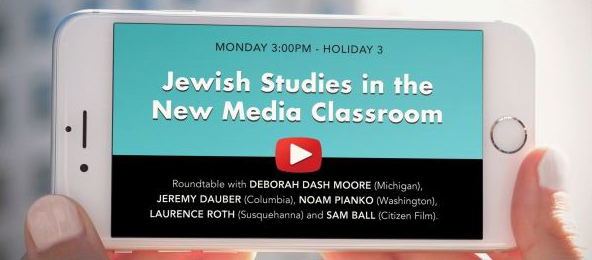Now Playing: Jewish Chicago
“He led a famous boycott of German goods in the 30’s and even led a secret spy mission for the government,” she said, standing near an exhibit about him. “I’m learning a lot about him and others like him who were Jewish and who made a big difference here.”
Indeed he did, and judging from the crowd of young people talking about him at the Chicago History Museum on a recent Sunday morning, his legacy provokes thought, inspiration and pride.
The 12-year-old was one of a busload of students from Congregation Beth Judea who trekked about 35 miles from Long Grove to see the Shalom Chicago exhibit and take part in educational activities surrounding it.
Shalom Chicago, which opened last fall and runs through early September, tells the story of the Jewish community here from the 1840s to the present. It uses personal stories, like Mandel’s, and artifacts, like an almanac printed by the Jewish-owned Vienna Sausage Co., plus photographs and videos, such as a black-and-white one capturing an anti-Hitler rally in the city in 1933.
“We don’t do a whole lot in our synagogue classrooms on the Jewish history of Chicago, so this gives us that opportunity,” said Marci Dickman, an educator at Evanston’s Beth Emet Free Synagogue. “Today, this is our classroom, and it’s invaluable.”
Last fall, Dickman joined a group of Chicago-area Jewish educators at the museum to preview the exhibit and explore ways to make it into a teaching opportunity, both on site and back in the classroom. On this day, she accompanied about 50 students – fifth- and sixth-graders, plus some high schoolers – to walk the exhibit and participate in related educational programming allowing them to more than just view, but to better focus, absorb, interact and interpret.
One activity had students describing the thoughts, ideas, visions and motivations of key Jewish figures in Chicago history. Another led them to analyze original photographs of Jewish events and venues, such as the Maxwell Street Market, an enclave of Eastern European Jews in the early 1900’s and still bustling today.
“Because I’ve already learned Hebrew it’s so amazing to be able to decipher the Yiddish signs at Maxwell Street,” Quin Goss, a 5th-grade student at Beth Emet Free Synagogue, said as he examined a turn-of-the-century image from the district and went through an exercise to interpret it and delve into its nuances. “It’s amazing to see what Chicago was like back then. Now that I have a connection to it, it means a lot to me.”
The approximately 500-square-foot exhibition space devoted to 175-years of Jewish Chicago is the nucleus of expansive educational programming – supported by The Covenant Foundation – spilling beyond the gallery walls into schools and onto the streets of the city itself.
“The history we are trying to tell lives outside of our walls,” said Libby Mahoney, the museum’s curator. “So part of our mission is to connect the exhibit with a living city.”
So educational outreach extends not only to Jewish school groups that are descending on the Chicago History Museum with regular frequency, but also to families, adults, seniors and others interested in the rich history and contributions of Jewish Chicago.
Nearly an entire year of programming runs the gamut from the serious to the playful, but all with a decidedly Jewish twist meant to engage, enlighten, educate and build upon questions, interests and connections made within the museum itself.
The ever-expanding lineup includes a theater series focusing on Jewish playwrights, directors, and themes – such as one dramatizing Jewish immigrant life on Maxwell Street – in collaboration with Northlight Theatre in Skokie; partnerships with other museums, like one with the National Museum of Mexican Art to explore the Mexican-Jewish population in Chicago and the synagogues of Mexico; a symposium on chicken soup; book lectures; Mah Jongg lessons and tournaments; and even bus and walking tours of Jewish Chicago.
“People have different preferences for how they want to learn,” said Lynn McRainey, Director of Education at the museum. “These programs are telling stories that an exhibit simply cannot. The Jewish story cannot be locked in the exhibit room. It can begin here, but the dialogue must – and should – continue beyond it.”
Outside the gallery, in a community room on the way out to their buses, the students from area congregational schools sat at communal tables to debrief and share thoughts on poster boards.
“There is more to history than meets the eye,” one student wrote. “There are a lot of famous Jewish people here. Thanks for teaching and making me think about them.”
By H. Glenn Rosenkrantz, for The Covenant Foundation


